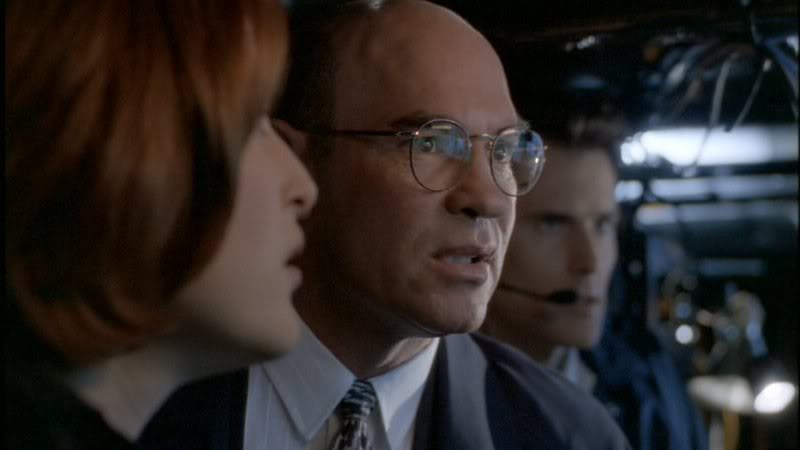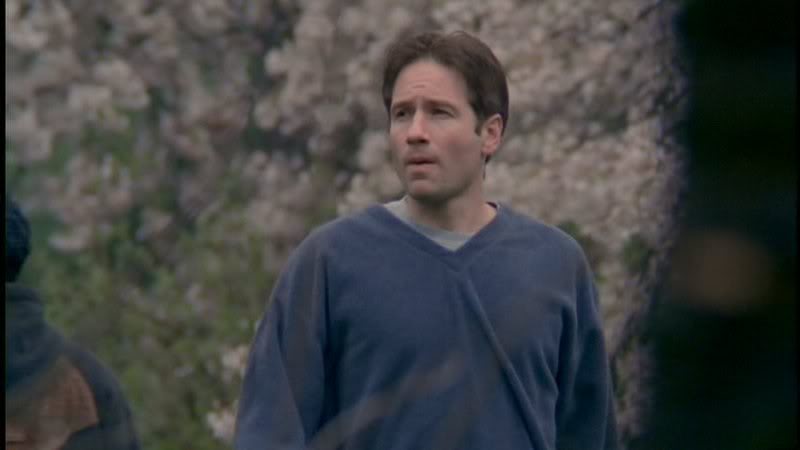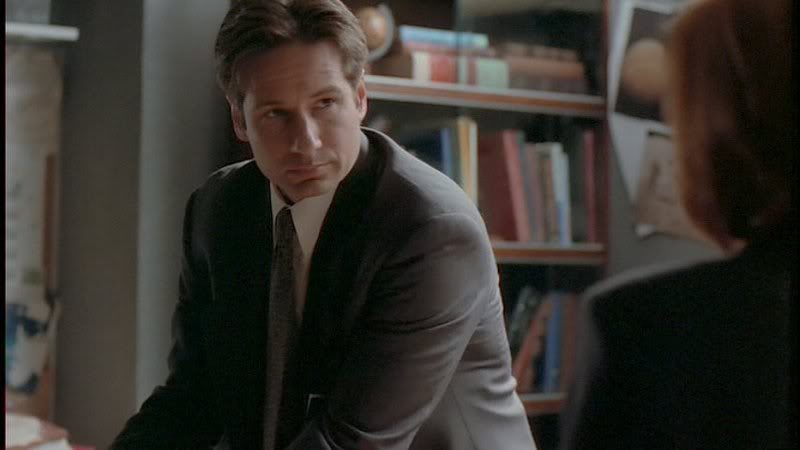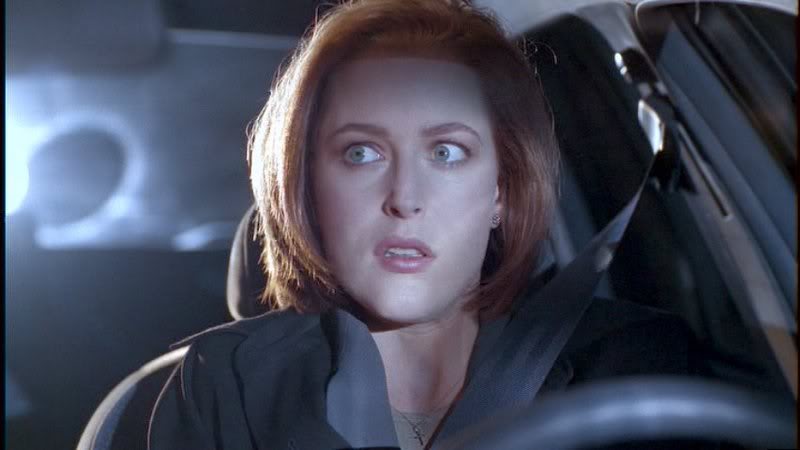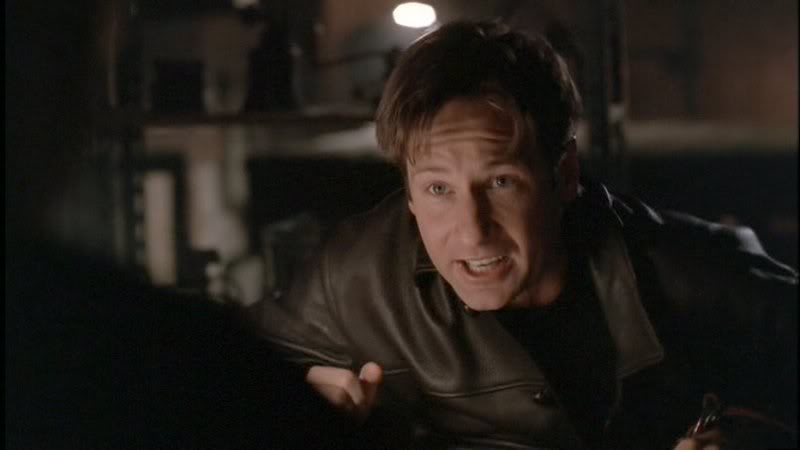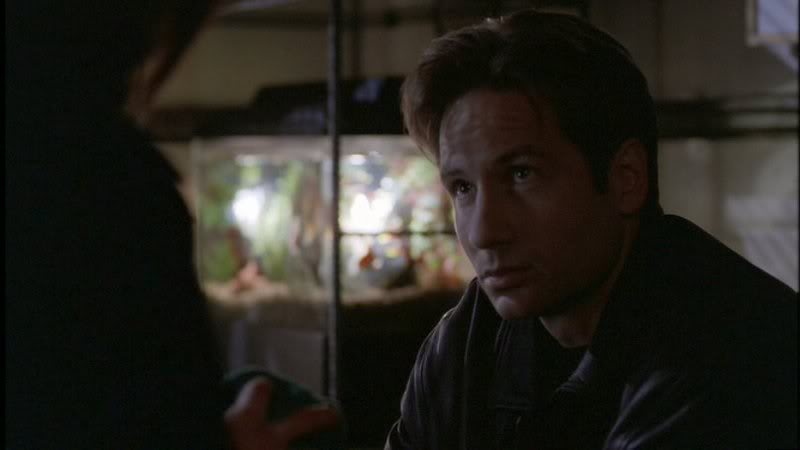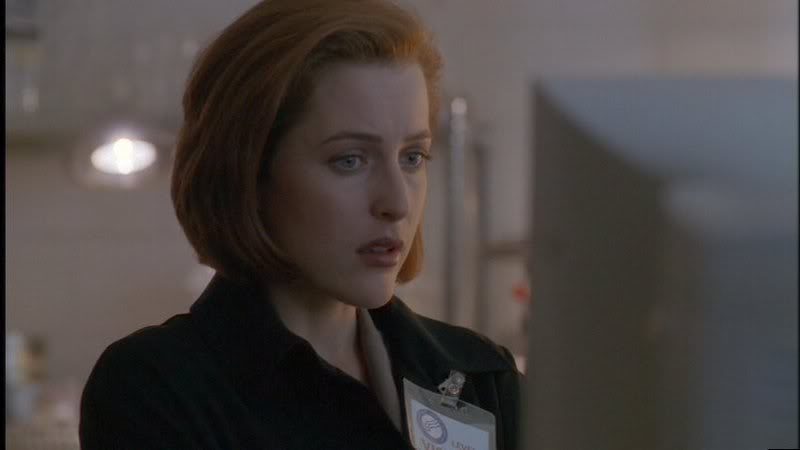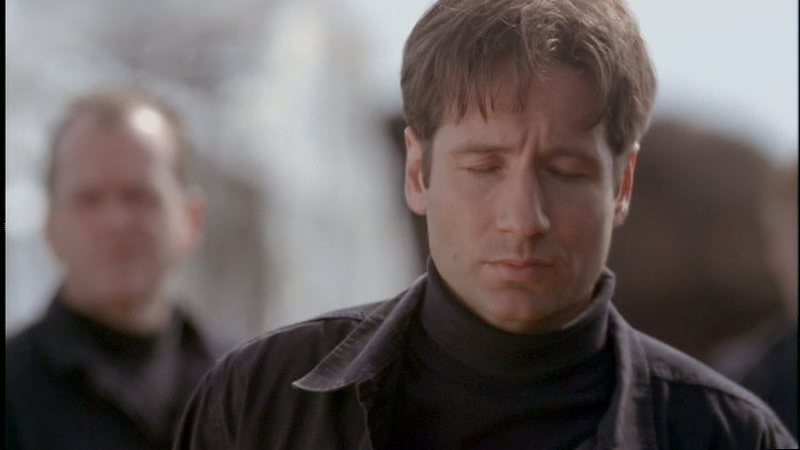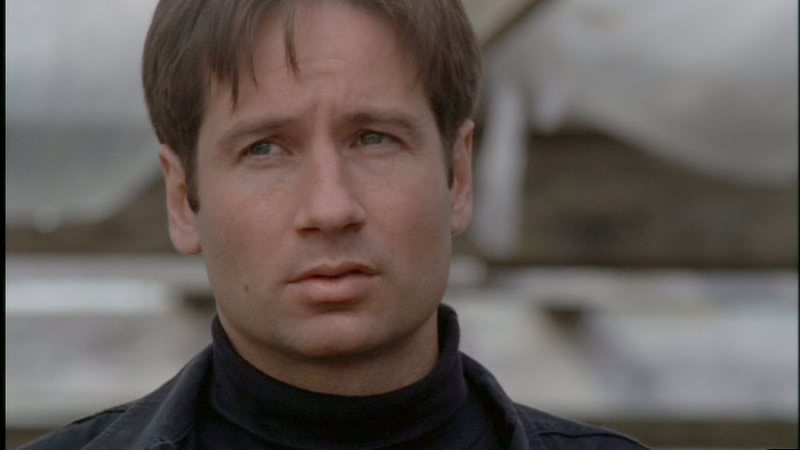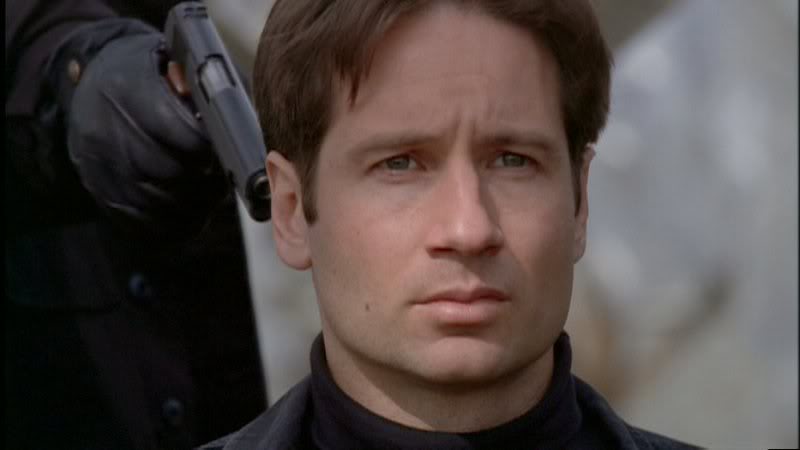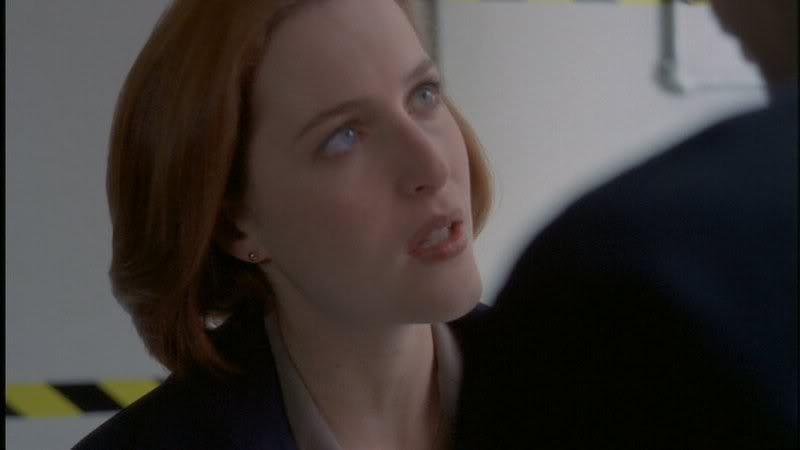CTP Episode of the Day - 11.30.06 – The Pine Bluff Variant
Today's Cherished Episode: The Pine Bluff Variant (5x18)
Original Air Date: May 3, 1998
Written By: John Shiban
Directed By: Rob BowmanPlaying a dangerous double game, Mulder infiltrates a gang of domestic terrorists.
"You're a believer?"
"I have my beliefs."
"You willing to die for them?"
"I'd prefer it didn't come to that."Some "The Pine Bluff Variant" Tidbits & Musings:
-- Title - Pine Bluff is a city in Arkansas; a U.S. biological warfare compound existed there during the Cold War. The "variant" part of the title refers to a disease or viral strain -- much like Ebola Reston is a variant of the Ebola virus named for the place it was discovered -- Reston, Virginia.
-- Alec Leamas, a disillusioned former British intelligence officer, "defects" to East Germany as part of an elaborate plan to sow disinformation and uncover a mole inside the spy organization's London headquarters. Once in place, Leamas gradually realizes that he has been deceived; that he is merely an expendable cog in a larger, infinitely more convoluted scheme. His struggle to save himself, and his soul, becomes his prime mission.
-- Sound vaguely familiar? The above is a fair account of the plot of The Spy Who Came In From the Cold, John le Carre's seminal Cold War spy novel, later made into a 1965 movie starring Richard Burton. Both the book and movie were particular favorites of X-Files co-producer John Shiban, who, for several years, had an index card pinned to his bulletin board that read simply "MULDER UNDERCOVER."
-- "The great thing about The X-Files was that it could lend itself to so many different types of genres," Shiban said. "We did comedies, horror stories, drama -- the paradigm could be stretched to do lots of different things. And I wanted to do a thriller, like The Spy Who Came In From the Cold, with Mulder undercover, putting him in a situation where he had to lie so that they wouldn't know his allegiance and eventually we wouldn't know his allegiance. That three by five card stayed on my bulletin board for a couple of years because we had to find the right moment in the history of the series to do that kind of story. Season 5 turned out to be the right moment, because we had been playing with who Mulder was and what he actually believed. So I kept saying to Frank (Spotnitz), 'I want to do this to Mulder.' And finally, we found the right time and the right way to do it."
-- One reason that the time was right, according to Shiban, was that Mulder's initial deception of Scully highlighted the growing, season-long alienation between the partners. Another was that the Cold War being over, Shiban had the opportunity to introduce a more up-to-date bogeyman: the domestic terrorist/militia movement. "We hadn't really planned to do it," said Shiban, "but it was a fortunate opportunity to open up that subject, to start the ball rolling. It worked out nicely."
-- To come up with his main plot device the writer had only to dip down into the current controversies of the day -- the suspicion and fears swirling around Saddam Hussein's alleged production and concealment of biological weapons; the near nightly TV news reports of "flesh-eating" bacteria; and the fact that the Pine Bluff Arsenal, thirty-five miles from Little Rock, Arkansas, was indeed a real Army base -- and contained a major stockpile of U.S. chemical weapons.
-- The teaser which took place in "Folger Park" in Washington, D.C., was shot in a park in Vancouver. The location was selected because of the park's abundant cherry blossoms that evoked the feeling of Washington in springtime. The Capitol Dome, which can be seen in the distance in several shots, was added in postproduction using computer generated images.
-- A good job was done hiding the fact that it was pouring rain during the teaser ... but the guy sitting on the park bench reading a soaked newspaper was a dead giveaway.
-- Shots used in the episode, including much of the teaser, were inspired by the 1995 Michael Mann film Heat, which included lots of good action scenes and surveillance sequences. "The long lens surveillance-type shots mixed in with Steady-Cam shots mixed in with traditional close-ups made for something different and exciting for the show" said Shiban. "And that's what I was going for. And then you add Action Mulder!"
-- "We liked to say 'Action Mulder' when we were coming up with these stories," Shiban laughed as he recalled Mulder's run through the park in the teaser. "The great thing about David Duchovny was that he could play a lot of roles. He was great with comedy, with action, with the cool, sort of detached cynical character that Mulder was. He quite enjoyed this episode because he got to play a different side of Mulder."
-- Though Duchovny did most of the "Action Mulder" work in the teaser, it was actually his double who was seen from Scully's point of view letting Haley escape. "Unfortunately, when you're on a TV schedule you have to pick up shots at different times and sometimes the principals are off shooting the next episode already," explained Shiban, "so we had to do that piece without David. But it cut together well and it's not really noticeable."
-- "The episode was all about paranoia, as is The X-Files in a lot of ways," Shiban said. "And the first half of this story was Scully's -- her paranoia about Mulder when she saw him do something very un-Mulder-like -- conspire with terrorists. She began to have doubts about him, and this fit in extremely well with everything that was going on in Season 5. There was a tension between Mulder and Scully from the very beginning of the season. And that was the idea -- to mix it up, their beliefs and their level of trust in each other. That's why this story fit so well into the flow of the season. Even though this was a stand-alone episode, it still played on the basic theme of the show -- trust no one."
-- "For example," Shiban continued, "Scully wanted to know the truth from Mulder, and Scully's character is such that she would just ask him. And what's shocking to the audience and part of the fun of this is that Mulder won't tell her. He's got a secret. Normally, you might not buy that. But in the context of Season 5, you really believe that might be true."
-- Skinner said that August Bremer took an interest in Mulder when he heard him speak about the government hoax at an alien abductee conference. This was a bit of continuity -- a reference to the conference that Mulder was attending at the beginning of "Patient X."
-- "The Spy Who Came In From the Cold was an intricate mystery, lies upon lies upon lies," explained Shiban. "The audience doesn't know who to believe. And we were trying to do that here in 43 minutes which is the running time of the television show, real time, not counting the commercials. And I think we did a terrific job of telling this kind of intricate story. In praise of [director] Rob Bowman, it has a very movie-like feel. It's really amazingly directed especially considering that you shoot these things in about eight days where you shoot your average movie in maybe three, four, five, ten times that, so it was really a pleasure."
-- Shiban also credited Mark Snow for the "movie-like" feel of the episode: "That's the other thing that makes this episode special and a little different than other episodes. Mark's score was very thriller-like, where I would characterize The X-Files as usually having a haunting and moody, scary type of music. This drives throughout which I was very pleased with and I think works very well."
-- U. S. Attorney Leamus was named for Alec Leamas, the British spy "who came in from the cold" in le Carre's novel. The role was played by Richard Burton in the movie. "All the writers loved to put in those little nods," Shiban said. "And I think the fans had a good time trying to find them and figure out what they meant."
-- "Chris Carter said from the very beginning that 'it's only as scary as it is real,'" Shiban recalled. "So we made a lot of effort and did a lot of research to try and give the illusion that this could be happening. I was really pleased with the internet response that I got to this episode," he added. "People were saying things like 'a vampire is scary, but I don't think I'm going to meet up with a vampire. But this could really happen.'"
-- Sometimes the possible reality is unsettling even for the writer. "Watching this episode again in light of the World Trade Center attack is a creepy feeling," Shiban said, "because as a writer and storyteller you try to push the envelope and make things as scary as possible and when they come true, it makes you think about your role as a storyteller. I still believe drama is supposed to face those things in the world that are scary. It's how we deal with it."
-- The movie theater usherette was Kate Braidwood's first speaking/credited role on the series. Kate is the daughter of X-Files first assistant director Tom "Frohike" Braidwood. "She actually read for the part and was very good so we cast her," Shiban said.
-- "I remember Rob Bowman called me from the set and said, 'I just did a Kubrick shot. You're gonna love it,'" said Shiban, referring to the shot of August Bremer in the lobby of the movie theater which set the mood for the audience to determine that Bremer was a bad guy. Bowman was indicating that his shot was similar to those used by famed director Stanley Kubrick.
-- The Aaron Burr Motor Court was Shiban's nod to history and another American traitor. Aaron Burr (Thomas Jefferson's Vice President but better known for his duel with Alexander Hamilton that resulted in Hamilton's death) was accused of treason in 1807 but was eventually acquitted. His story parallels that of Mulder in that both were accused of being traitors but both were later exonerated.
-- "This was a motel that we actually used several times in The X-Files if you watch the show carefully," explained Shiban. "Vancouver was a great place to shoot. There were a lot of locations to choose from, but sometimes when you tried to match America you ended up using the same places again and again because there weren't that many motels in the same style that we had in the States."
-- Veteran Mulder Fashion Watchers knew that something was amiss in this episode when we saw Mulder in his tan and un-sexy (and definitely not for funky poaching) khaki pants that he wore in the "Pilot" and apparently dug out of mothballs.
-- "I always wanted to do something in a theater in one of my episodes," Shiban said. "My inspiration for that was that I spent many years working as an usher at various movie theaters in Los Angeles." The movie theater scenes were filmed at the Dunbar Theater in Vancouver, a real movie theater.
-- The movie showing at the theater in the episode was Die Hard With a Vengeance. "To be perfectly honest," laughed Shiban, "it was a Fox film so we could get it cheap and we picked that. But it also had a terrorist theme, so it fit in."
-- When Scully asked for Mr. Kaplan at the Aaron Burr Motor Court, it was the writer's homage to Alfred Hitchcock's North by Northwest. In the film, George Kaplan was the CIA-assigned pseudonym to an imaginary secret agent registered at hotels all around the country, the mysterious character that Cary Grant was following and was mistaken for in the movie.
-- Both Mulder and Scully nearly get to utter The X-Files' most famous unfinished phrase in this episode, "Shi..." Scully when she's getting run off the road, and Mulder during the game of "pull my finger."
-- "Scully being run off the road at the end of the first act was what we call an 'act out,'" Shiban explained. "In television, acts are divided by commercial breaks. When you're boarding a story -- building it, outlining it -- you want to engage the audience and to do something that will bring them back after the commercial because they want to know what happened. And this was a perfect example of that. Scully was stopped by men with guns -- were they the terrorists, the government? Was she in trouble? So the audience had to tune in after the commercial to see what happened next."
-- The scene in which Scully learns the truth about Mulder's involvement from Skinner and Leamus was filmed in a building in downtown Vancouver. The art department painted the hallway and the office where the scene was shot. "The deep green chosen by art director Graeme Murray was really interesting to me," said Shiban, "because not only was it spooky but it gave it a government feel, an officialdom feel. Graeme was very good at playing with the palette of the show but keeping it dark and moody at all times."
-- "I started with the show at the beginning of Season 3," Shiban recalled, "and the show grew so much technically in such a short period of time. The effects got so much better, it was amazing to me. But when a show is a success, it also has to find ways to grow in directions that are unexpected and interesting to keep it alive. Chris felt very strongly about this and I think we all agreed. Even though sometimes the audience worries that the show they love is going to change, if you don't mix it up, the show stagnates. The show wouldn't have continued to be as successful and good as it was if we hadn't tried some different things along the way."
-- "Finding new directions are also necessary to keep the actors interested," Shiban continued. "Their characters have changed over the years, and they don't want to play the same thing every week. I think this episode was great in that both David and Gillian got to play different facets of their characters."
-- "I wanted a really intense torture scene," said Shiban of Mulder's meeting with Haley. "And I think we got it. It was marvelously edited by Lynne Willingham. The tension just kept going and it made your stomach hurt."
-- Mulder's line, "Is this the Pepsi challenge?" was David Duchovny's improvisation. "We loved it so much, we put it in the show," said Shiban. "David actually did a lot of that over the years. He came up with some great Mulder lines that we would use."
-- "I always loved the head butt David gave the guy in the torture scene," Shiban said, "and David loved doing it. It was very cool for Mulder to have that kind of guts. You want a hero like that."
-- "We had a quite a debate among the writing staff over which finger was the scariest to break," said Shiban. "The thumb or the forefinger, and finally I went for the pinky because it was so easy to break and somehow it just seemed so fragile. That's the kind of stuff you talked about for hours and hours when you were on the writing staff of The X-Files. What's the scariest 'this,' what's the most disgusting 'that.' So it was a fun job in that way for those with a twisted point of view."
-- "When we broke the finger in act two, we didn't anticipate that it would become so important," Shiban said. "When you're shooting a television show, you need a new script every eight days in order to fill the required number of episodes for the year. So you're usually still working on the script while the crew is shooting. Shooting had already started on this episode and I was still rewriting and there was a plot point that I just couldn't figure out. I remember talking to Chris Carter and Frank Spotnitz about how Scully would recognize Mulder in act four on the videotape that was shot at the bank robberies. And suddenly it just occurred to us -- the broken finger will have a cast! That's one of the serendipitous things that happens a lot especially in television because you don't have the time always to outline as much as you'd like or to write as carefully as you'd like and you have to keep making it better as you go."
-- "The scene with Scully and Skinner and the bodies in the movie theater was handled really well," Shiban said. "The danger in television and any sort of dramatic art is that you don't want to be too graphic that your audience is turned off but you want to be graphic enough that it's scary and impactful. One of the things that Rob did well here was cover the bodies in plastic and then use the famous Xenons. That's a specific Xenon flashlight that The X-Files sort of made famous and you see a lot on the show. That piercing light that cuts through the smoke. I thought that the way that was handled really played not only the scare but also allowed us to show it on television without Standards and Practices questioning it."
-- "And the end of act two we wanted to turn the tables on the audience again," Shiban said. "So instead of just ending on that nice Mulder/Scully moment where the characters were in concert again, we showed Bremer outside listening so the audience realized the characters were in danger." It was actor Michael MacRae's (Bremer) idea to be smoking the cigar in that scene. "It wasn't something I would have thought of but worked great for the character," Shiban said.
-- The tape residue on Mulder's window was a reference to earlier in the year when Mulder removed the "X" he put up whenever he would want to speak to Deep Throat or Mr. X.
-- "It sounds silly," said Shiban, "but another big thing we debated in the writers' room was the time that we put in the legends. Sometimes they meant something, sometimes they were birthdays, but other times it was just because it sounded right. For instance, for some reason 3:14 sounded better than 3:15. It was really a taste thing, but it was one other writer thing we debated about."
-- The scene between Mulder, Skinner, and Leamus in the FBI Building was included not only to move the plot forward, but to plant the seed for Skinner to begin to question Leamus' plan, a plot point that would pay off at the end of the episode. "One of the great things about Skinner was that he was protective of his agents," Shiban said. "Even if he disagreed with Mulder and Scully, he was very protective of them and he let them know that he was worried."
-- "The patented Scully science lab scene was something we began to do less of over the years, again to mix up the show and do things differently," Shiban explained. "But she was a scientist and this was her specialty and why she was on the X-Files. Gillian was very good at playing these scientific mumbo-jumbo talk scenes. They were actually not only just for clarity but I think emotionally Scully felt this was the key to solving the X-File cases -- through the science."
-- The New Spartans farmhouse location was "fabulous," said Shiban. "It was an abandoned greenhouse outside of Vancouver, near Vancouver Airport. When we were scouting locations, the minute Rob Bowman saw those sheets of plastic hanging from the old arbors, he decided that was going to become a theme within the episode. He had the art directors putting hanging plastic in lots of places in the show. He said the plastic was hard to see through, it obscured, and that was what was behind the episode. So you see a lot of hanging plastic everywhere and it was all inspired by the farmhouse location. It didn't occur to anyone until we saw that location and how cool that looked."
-- The terrorists used monster masks to hide their faces while robbing the bank, and the Dracula mask was David Duchovny's request. "In the script, I wrote a wolfman mask," said Shiban. "And David called us and said that Dracula was one of his favorite characters when he was growing up and asked if it could be a Dracula mask. The masks were inspired by a couple of sources, A Clockwork Orange and The Killing, two Stanley Kubrick films. We didn't want the masks to look comical, and they actually turned out great. David's mask was sort of the Christopher Lee version of Dracula. I really loved the skeletor mask which was worn by the fellow who was referred to in the script as the Skinhead Man. But I probably should have called him Man Who Breaks Mulder's Finger."
-- To play the part of the First Sovereign Bank of Pennsylvania, the production team rented and renovated an abandoned Canadian government money depository -- complete with a 4,900-square foot bank vault and 8,000 pound steel door -- in downtown Vancouver. For the bank robbery scenes they assembled more than $15,000 in U.S. currency and were promptly chided by the Royal Canadian Mounted Police for creating a security risk.
-- "When the place was an actual bank, it held about five billion dollars," noted art director Greg Loewen. "One day during the shoot, we sat outside and wondered how many of these buildings Bill Gates would need to stash all his cash in."
-- Rob Bowman designed and executed the one shot scene that took the viewer from the money in the bank all the way to bring the terrorists out of their van. "Not only was it artistically beautiful and filled with tension," said Shiban, "but it also made it produceable on a television budget and schedule. Television is very tight. And to get this kind of scale he had to design some things that were done as what we call 'oners,' which means one shot. It worked so well that you don't miss that you're not getting close-ups or you're not getting things to cut to."
-- Oopsie! During the bank robbery when the bank officer first unlocked the back door to meet the "Brinkley" truck, the clock read 9:45. Later, when he was opening the safe, the same clock read minutes earlier.
-- The bank robbery scene was also inspired by Heat and a number of other bank robbery films. "But you always try to do things your own way, to bring new wrinkles to it," Shiban noted, "and obviously Mulder being in the middle of this and having this huge dilemma -- will he let innocent people get killed, will he kill an innocent person to keep his cover -- made it more interesting. This was a different kind of act-out. It was something we call a 'play-through' -- where you return to the same piece of action after the break -- in this case, Mulder aiming a gun at the teller before the commercial, then coming back where you left off after the commercial. Those do not always work, to be honest, because it's sort of an old-style television, Mission: Impossible kind of thing to do. Part of the problem for me at least is that when you do those, the tension can go out. But I felt here it worked because the tension was so high and you're moving so fast that when the audience returned, they didn't feel like they had missed anything."
-- Part of the reason money was chosen as the delivery system for the biotoxin was keeping with Chris Carter's "it's only as scary as it is real" credo. "As we were boarding the story, Chris actually said to me, 'I want people to open their wallet and be afraid to touch their money thinking there could be biotoxin on it,' recalled Shiban. "There was actually research that showed that most of the large bills in American circulation right now probably have microscopic bits of cocaine on them just because they were passed through some drug dealers' hands. And we wanted to play on that idea that it wouldn't take much. Again, it's scarier now in that America has been attacked by terrorists. In retrospect, it's kind of creepy to think that we talked about things like that but again, drama is here to deal with our fears and to help the audience deal with their fears."
-- "The scene where Bremer burned the stolen money and the deception was revealed was quite hard to write," Shiban said. "It was very convoluted, a lot of twists and turns, and I wanted the audience to be clear on what was happening. Luckily, when you're a writer on this show, it's quite a collaborative effort, so we always give notes, help each other to make each other's scripts better. I can recall doing a lot of drafts of this one, and getting a lot of notes trying to make this scene and this moment as strong as possible."
-- Rob Bowman referred to the scene where Mulder was facing execution as "Mulder's death march." "We talked a lot about it and in a weird way were all excited to do it," said Shiban. "It's very hard in a returning TV series to put the audience in a frame of mind that they think a main character might get killed. The audience knows this is David Duchovny, one of the stars, and that he's going to be back next week. So the trick is to make it as tension-filled as possible and find the most interesting way to solve the problem, because the audience knows you're going to solve it. They know the writer will find a way to save Mulder."
-- The long Dolly-shot used to film "Mulder's death march" through the haunting layers of plastic was the longest section of Dolly track ever set up for an X-Files episode before or since.
-- "The trick in the execution scene was to build the tension for the audience even though they knew Mulder would be saved," Shiban said. "So we made things look worse and worse. And hopefully the viewers had no suspicion at that point in the story that Bremer had a secret too. What excited me about The Spy Who Came In From the Cold, my original inspiration for the episode, was that the spy that Richard Burton was trying to catch turned out to be working for us. He was a bad man but he was working for us and it was a moral dilemma that every country has to face. Do you work with these types of people who swim in these dark waters in order to try to stop others? And that's what Mulder had to face here."
-- I love the mixture of Mulder's heartbeat with the music as everything changed to slow motion; his reaction to the shot, his stunned amazement that he was still alive and might live to fight the future (coming that summer to a theater near you!), and his confusion regarding Bremer's true identity and why he was being let go.
-- "The shot that led Mulder away after being saved went on for much longer," said Shiban, "and I wish we could have kept it, but unfortunately time is limited and we had to cut it."
-- "The scene with Mulder and Scully confronting Leamus was one of those scenes that are just a joy to write for Scully's character," recalled Shiban. "Because Scully was always reasonable, scientific, a very, very, very smart character, and then every once in a while on the show, we would allow her to get angry. And when she did, and Gillian was so good at it, it was shocking for us as audience members who love Scully to see her as what we liked to call 'Scully Taking Names.' You don't want to see that every week, it's not Scully's personality, she's usually the rational one, but it was great when it happened."
-- "We tried to leave the audience with the moral dilemma here and the question for Mulder -- what was he trying to do with his quest for the truth? If his quest for the truth meant exposing this government operation that was ostensibly in theory trying to stop terrorists, would that be helping the terrorists? It was a very interesting quandary for Mulder, and hopefully left something for the audience to consider. To me, the best of The X-Files was that in the context of a fantasy, science fiction show, or whatever you wanted to call it, you could deal with real world dilemmas. How do you fight these people and do you fight them using their own weapons?"
-- "I was very, very happy with this episode," John Shiban said. "Not only in the directing and the acting and art direction, but also in where it fit in The X-Files in the grand scheme of the show. I felt there was a nice twist, a nice change of pace for Mulder and Scully, and a nice place to step off for the next week when hopefully the audience came back."
-- Sam Anderson (Leamus) had a recurring role on ER as Dr. Jack Kayson and can currently be seen as Bernard on Lost.
-- Daniel von Bargen (Haley) moved on to a recurring role on another Sunday night Fox series. He played Commandant Edwin Spangler on Malcolm in the Middle.
-- "On The X-Files we were blessed with an amazing cast," John Shiban said, "and not only the principals but we had some excellent casting people who always found a great guest cast. You'll see actually that we used some of the same people several times because of that, because when you find a good actor, you try to keep him." Which brings us to ...
-- Once & Future Retreads: Michael MacRae (August Bremer) was Ranger Peter Brullet in "The Jersey Devil." J. B. Bivens (Field Agent) was a Truck Driver in the "Pilot" and a Sharpshooter in "End Game." Dean McKenzie (Army Tech) was Lt. Blaine in "2Shy." Kate Braidwood (Usherette) was a Girl in the Restaurant in "Talitha Cumi" and a Day Room Patient in "Elegy." Michael St. John Smith (CIA Operative) was The Major General in "Musings of a Cigarette-Smoking Man." Don Thompson (Terrorist in Ghoul Mask) was Holtzman in "Conduit," Henry Willig in "Sleepless," and Lt. Col Victor Stans in "The Walk." Marek Wiedman (Bank Manager) was an Investigator in "Tempus Fugit." Ralph Alderman (Manager) was the Motel Manager in "Mind's Eye."
(Thanks to chrisnu for today's episode pics.)
-- When I watch XF episodes, you can throw any amount of blood and guts at me that you want; squirming maggots and rotting flesh don't phase me at all. But to this day, I cannot watch the scene where the Man Who Breaks Mulder's Finger snaps that digit. The sound alone nearly makes me lose my cookies!
Please share your first impressions, favorite (or cringe-worthy) moments, classic lines, favorite fanfic, nagging questions, repeated viewing observations, etc., as today we celebrate "The Pine Bluff Variant."
Polly
